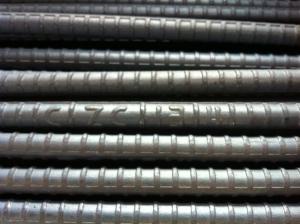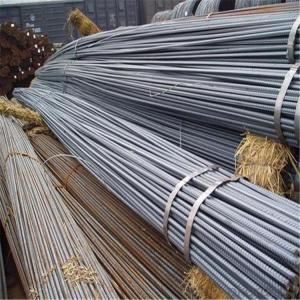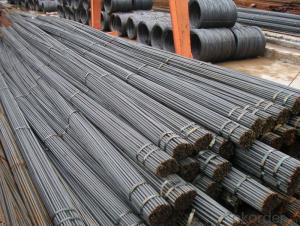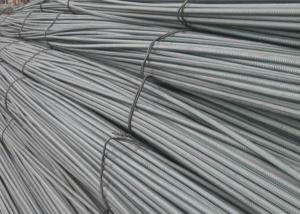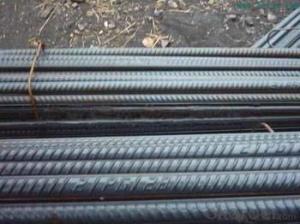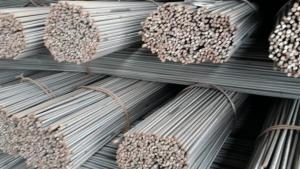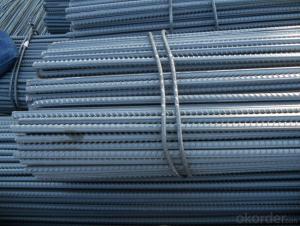GB Standard HRB335 Deformed Bars
- Loading Port:
- China Main Port
- Payment Terms:
- TT or LC
- Min Order Qty:
- -
- Supply Capability:
- -
OKorder Service Pledge
OKorder Financial Service
You Might Also Like
Product Description:
OKorder is offering GB Standard HRB335 Deformed Bars at great prices with worldwide shipping. Our supplier is a world-class manufacturer of steel, with our products utilized the world over. OKorder annually supplies products to African, South American and Asian markets. We provide quotations within 24 hours of receiving an inquiry and guarantee competitive prices.
Product Applications:
GB Standard HRB335 Deformed Bars are ideal for structural applications and are widely used in the construction of buildings and bridges, and the manufacturing, petrochemical, and transportation industries.
Product Advantages:
OKorder's GB Standard HRB335 Deformed Bars are durable, strong, and wide variety of sizes.
Main Product Features:
· Premium quality
· Prompt delivery & seaworthy packing (30 days after receiving deposit)
· Can be recycled and reused
· Mill test certification
· Professional Service
· Competitive pricing
Product Specifications:
Manufacture: Hot rolled
Grade: HRB335
Size: 6mm-25mm
Certificates: ISO, SGS, BV, CIQ
Length: 6m – 12m, as per customer request
Packaging: Export packing, nude packing, bundled
Grade | Technical data of the original chemical composition (%) | |||||||
C | Mn | Si | S | P | B | |||
HRB335 | ≤0.25 | ≤1.60 | ≤0.80 | ≤0.045 | ≤0.045 | >0.0008 | ||
Physics capability | ||||||||
Yield Strength(N/cm2) | Tensile Strength(N/cm2) | Elongation (%) | ||||||
≥335 | ≥490 | ≥16 | ||||||
FAQ:
Q1: Why buy Materials & Equipment from OKorder.com?
A1: All products offered byOKorder.com are carefully selected from China's most reliable manufacturing enterprises. Through its ISO certifications, OKorder.com adheres to the highest standards and a commitment to supply chain safety and customer satisfaction.
Q2: How do we guarantee the quality of our products?
A2: We have established an advanced quality management system which conducts strict quality tests at every step, from raw materials to the final product. At the same time, we provide extensive follow-up service assurances as required.
Q3: How soon can we receive the product after purchase?
A3: Within three days of placing an order, we will arrange production. The normal sizes with the normal grade can be produced within one month. The specific shipping date is dependent upon international and government factors, the delivery to international main port about 45-60days.
Images:
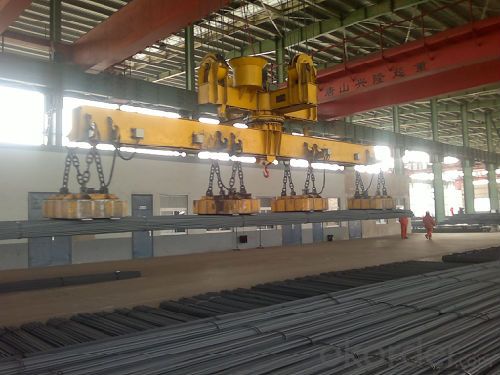

- Q: What kind of steel is carbon steel in threaded steel?
- China and some countries according to the guarantee of delivery conditions, the ordinary carbon steel is divided into three categories: a steel (a steel), only ensure the mechanical properties, does not guarantee the chemical composition, type B steel (B steel), only to ensure that the chemical composition, does not guarantee the mechanical properties; special steel (C steel). Not only guarantee the chemical composition, mechanical properties and guarantee. Special steel is often used to make more important structural parts.
- Q: Can steel rebars be used in stadium construction?
- Steel rebars are indeed applicable for stadium construction. These reinforcing steel bars are frequently utilized in concrete construction to confer robustness and stability. In the realm of stadium construction, steel rebars are extensively incorporated into reinforced concrete structures like columns, beams, slabs, and foundations. They are strategically positioned within the concrete to augment its capacity to bear loads and avert cracking or failure amidst substantial burdens and vibrations. By employing steel rebars, the stadium's structural integrity and longevity are ensured, granting it the ability to endure the tremendous pressures and forces exerted during sporting events and gatherings of a considerable audience.
- Q: What are the factors that determine the strength of steel rebars?
- Several factors contribute to the strength of steel rebars. Firstly, the composition of the steel used in their manufacture plays a crucial role. The presence of elements like carbon, manganese, and silicon significantly impacts the steel's strength by enhancing its ability to resist tension and provide structural stability. Secondly, the manufacturing process of rebars influences their strength. Quenching and tempering, a process involving rapid cooling after heating, is typically employed to achieve the desired strength. The precise temperature and duration of this process affect the grain structure and chemical properties of the steel, thereby impacting the rebars' strength. The size and shape of rebars also affect their strength. The diameter and length of a rebar determine its load-bearing capacity. Thicker and longer rebars generally possess higher strength as they can withstand greater stress and distribute it more effectively. Furthermore, the presence of impurities or defects in the steel can weaken rebars. Cracks, voids, or inclusions compromise the structural integrity of the rebar and reduce its strength. Finally, environmental conditions must be considered when determining the strength of rebars. Factors like temperature, humidity, and exposure to corrosive substances can impact their strength over time. Taking precautions, such as using corrosion-resistant coatings or stainless steel rebars, is essential to ensure the longevity and strength of rebars in such environments. In conclusion, the strength of steel rebars depends on the composition of the steel, the manufacturing process, the size and shape of the rebars, the presence of defects, and the environmental conditions in which they will be used. Considering these factors is crucial to ensure the durability and reliability of steel rebars in construction applications.
- Q: How are steel rebars priced in the market?
- Steel rebars are typically priced in the market based on factors such as the current cost of raw materials, supply and demand dynamics, production and transportation costs, and market competition. Additionally, the grade and quality of the rebar, as well as any additional processing or customization, can also influence the pricing.
- Q: Can steel rebars be used in earthquake-resistant construction?
- Yes, steel rebars can be used in earthquake-resistant construction. Steel rebars provide strength and reinforcement to concrete structures, making them more resistant to seismic forces during an earthquake. The ductility and flexibility of steel rebars allow them to absorb and distribute the energy generated by an earthquake, reducing the risk of structural failure and enhancing the overall resilience of the building.
- Q: What are the different grades of epoxy-coated steel rebars?
- The different grades of epoxy-coated steel rebars are typically classified based on their yield strength, which can range from Grade 40 to Grade 80. These grades signify the minimum yield strength in ksi (thousand pounds per square inch) that the rebar can withstand before it deforms.
- Q: Can steel rebars be used in corrosive chemical environments?
- No, steel rebars should not be used in corrosive chemical environments as they are susceptible to corrosion which can compromise their structural integrity.
- Q: Can steel rebars be used in wind turbine foundation construction?
- Yes, steel rebars can be used in wind turbine foundation construction. Rebars are commonly used in the construction industry to reinforce concrete structures and provide added strength and durability. In wind turbine foundation construction, steel rebars are typically embedded within the concrete to provide structural support and prevent cracking or failure. The rebars help distribute the load and forces exerted by the wind turbine, ensuring the stability and longevity of the foundation. Additionally, steel rebars have high tensile strength, making them suitable for withstanding the dynamic forces and vibrations experienced by wind turbines. Therefore, the use of steel rebars in wind turbine foundation construction is a common and effective practice.
- Q: What is the typical weight of a steel rebar?
- The typical weight of a steel rebar can vary depending on its diameter and length. However, the most commonly used steel rebar in construction projects is typically 20 feet long and ranges in diameter from 1/2 inch to 1 inch. For this standard size, the weight can range from around 7.5 pounds to 24 pounds per linear foot. Therefore, a 20-foot steel rebar can weigh anywhere between approximately 150 pounds to 480 pounds. It is important to note that different countries may have different weight standards for steel rebars, so it is always advisable to consult local specifications and standards for accurate information.
- Q: How are steel rebars protected from concrete spalling?
- Various methods and techniques are utilized to safeguard steel rebars from concrete spalling. One commonly employed approach involves the application of a concrete cover over the rebars. This entails embedding the rebars within the concrete structure to prevent direct exposure to external elements or conditions that may lead to spalling. To ensure adequate protection, construction codes and standards typically prescribe the thickness of the concrete cover. Another means of shielding steel rebars from concrete spalling is the use of corrosion inhibitors. These inhibitors are typically incorporated into the concrete mix during construction. They function by reducing the rate of corrosion for the steel rebars, effectively safeguarding them against spalling caused by rusting and corrosion. In addition to concrete cover and corrosion inhibitors, proper concrete mix design holds significant importance in protecting steel rebars. The utilization of high-quality concrete with an appropriate water-cement ratio, adequate strength, and suitable curing greatly enhances the concrete's resistance against spalling. This guarantees the secure embedding of the rebars within the concrete structure and shields them from moisture or other deteriorating agents that could lead to spalling. Furthermore, adhering to proper construction practices, such as thorough compaction of concrete, precise placement and alignment of rebars, and effective waterproofing measures, also contribute to the protection of steel rebars from concrete spalling. These practices help minimize the likelihood of moisture ingress and the formation of cracks or voids that could expose the rebars to the risk of spalling. In summary, a combination of concrete cover, corrosion inhibitors, appropriate concrete mix design, and sound construction practices are vital in safeguarding steel rebars from concrete spalling. By implementing these measures, the durability and lifespan of concrete structures can be significantly enhanced.
Send your message to us
GB Standard HRB335 Deformed Bars
- Loading Port:
- China Main Port
- Payment Terms:
- TT or LC
- Min Order Qty:
- -
- Supply Capability:
- -
OKorder Service Pledge
OKorder Financial Service
Similar products
Hot products
Hot Searches
Related keywords
